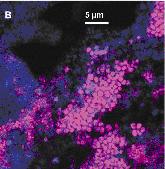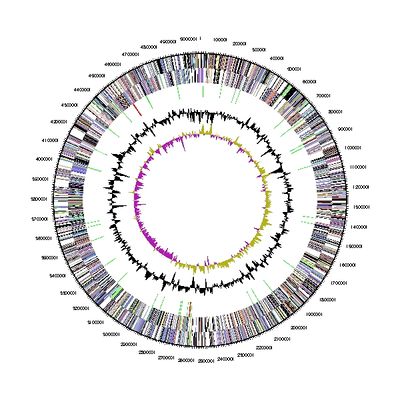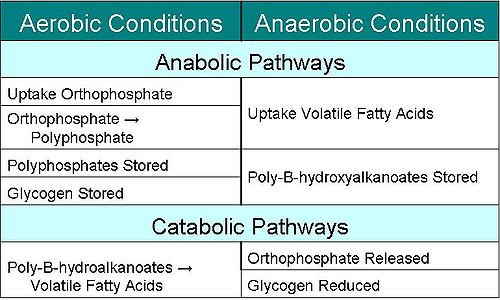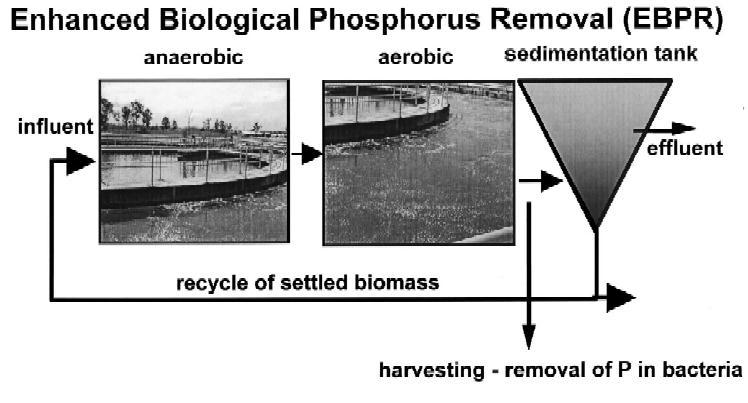Candidatus Accumulibacter Phosphatis
Classification
Kingdom: Bacteria
Phylum: Proteobacteria
Class: Betaproteobacteria
Order: unclassified Betaproteobacteria
Family: Candidatus Accumulibacter
Species
Candidatus Accumulibacter phosphatis
NCBI Taxonomy ID: 522306
Description and Significance
Candidatus Accumulibacter phosphatis (A. phosphatis) is ecologically significant because it is used to remove phosphorous from waste water. Waste water effluent can be a major contributor of phosphorous pollution to the environment, causing excess nutrient loading that leads to algal blooms. Traditional methods of phosphorous removal include chemical removal process and enhanced biological phosphorus removal (EBPR). A. phosphatis and other polyphosphate-accumulating organisms (PAO) are key species in the EBPR process. Advantages of operating a waste water treatment plant with EBPR are that it significantly lowers operating costs, reduces sludge production, enables sludge to be reused easier, and eliminates chemical byproducts used in chemical treatment methods (Blackall, 2002). A. phosphatis has been found in 4-18% of plants treating domestic sewage (Fukushima, 2007).
Genome Structure
Accumulibacter spp. has as many as eleven lineages so far discovered in full scale waste water treatment plant bioreactors around the world (Peterson, 2008). It is suspected that differences between lineages are due to competitive advantage in different environmental conditions (Peterson, 2008).
The ‘‘A. phosphatis’’ Genome consists of one circular chromosome and three plasmids.
The size of this genome is 5,306,133 base pairs, coding for 4,790 genes. 3.82% of the A. phosphatis genome is unlike all other organisms in relation to both sequence similarity and function.
The A. phosphatis clade IIA str. UW-1 was mapped by the Department of Energy Joint Genome Institute (DOE JGI) in 2004 with an isolate collected from an EBPR wastewater treatment bioreactor in Madison, WI.
Oligonucleotide probes which can help detect DNA and RNA sequences specific to A. phosphatis have been developed. This has allowed for studies of A. phosphatis using fluorescent in situ hybridization and polymerase chain reactions (PCR) (Blackall, 2002).
Cell Structure, Metabolism, and Life Cycle
Cell Structure
A. phosphatis is a gram negative, rod shaped organism.
Metabolism
A. phosphatis is a chemoheterotroph and can exist in both aerobic and anaerobic conditions. This organism has an interesting metabolism, adapted for survival in both aerobic and anaerobic environments. It cycles molecules for energy generation or storage depending on the environmental conditions. A. phosphatis is an acetate oxidizer
Aerobic Conditions
Anabolic Pathway: Under aerobic conditions A. phosphatis uptakes orthophosphate from the environment and transforms it to polyphosphate, an energy rich phosphate chain. Polyphosphates are stored until conditions change from aerobic to anaerobic. A. phosphatis also stores glycogen in a similar manner to polyphosphate (Zhoua 2009).
Catabolic Pathway: Poly-B-hydroxyalkanoates (PHAs), stored during anaerobic conditions, are reduced to produce energy for growth (Levantesi 2002).
Anaerobic Conditions
Anabolic Pathway: Under anaerobic conditions A. phosphatis uptakes VFAs and stores the carbon in the cell as PHAs (Levantesi 2002).
Catabolic Pathway: Polyphosphate, stored during aerobic conditions, is reduced to orthophosphate for the purpose of energy generation. The orthophosphate is released into the environment (Pijuan 2003). Another pathway exists through the reduction of glycogen by glycolysis. This process produces ATP and NADH reducing equivalents (Blackall, 2002).
Summary of metabolism for A. phosphatis.
Ecology and Pathogenesis
Industrial Habitat: A. phosphatis inhabits sediment and sludge in waste water treatment facilities. It is seeded in industrial wastewater treatment bioreactors for the purpose of accumulating phosphorous in the EBPR process. The EBPR process involves using bacteria to accumulate phosphorous in their cells so that it can be easily separated from waste water. The bacteria accumulate in a layer of solids in the bottom of the waste water treatment bioreactors called the sludge layer. Once an initial culture of A. phosphatis is successfully developed in aerobic wastewater sludge layers, small amounts of the sludge is put back into the beginning of the system, or mixed with the anaerobic incoming wastewater, in order to start a new culture of phosphate removing microbes. The microbes will reproduce, consume and concentrate phosphorous in their biomass, and accumulate in the aerobic sludge layer. At this point, the process begins again. The use of anaerobic and aerobic tanks is important because of the differences in metabolism depending on the conditions. A. phosphatis stores phosphate in the aerobic stage.
Natural Habitat: A. phosphatis was recently found in estuary and fresh water sediments (Peterson, 2008). Survey of freshwater, terrestrial, and estuary soil samples with PCR indicated presence of Accumulibacter. Additional evidence for the existence of ‘’A. phosphatis’’ in a natural environment is that genetic sequencing of this species in labs on two different continents showed close genetic similarity (Peterson, 2008). Sequence similarities over large distances leads to a high probability that A. phosphatis exists in the space in between the tested locations, allowing for gene transfer. This species has numerous traits that could give it competitive advantage in oligotrophic environments, including accelerated phosphorous and nitrogen uptake (Peterson, 2008).
Biogeochemical Significance: A. phosphatis is a type of polyphosphate accumulating organism (PAO). PAOs are able to accumulate large amounts of phosphorus in the anaerobic zones of waste water treatment sludge. Sludge that was formed with the help of PAOs measures 4-5% phosphorous content by dry weight; this is in contrast to 1.5-2% phosphorous content by dry weight in the absence of PAOs (Blackall, 2002).
Interaction With Other Microbes: A. phosphatis competes for resources with glycogen-accumulating organisms (GAO) because they both thrive on the same carbon source- acetate (Schroeder, 2008). This is undesirable in wastewater treatment processes because GAOs do not provide the favorable phosphate removing processes that PAOs do. Attempts have been made to give A. phosphatis a competitive advantage over GAOs by supplementation of a different carbon source, but no successful results have been yielded so far (Schroeder, 2008). The sludge layers that commonly contain A. phosphatis also have communities of actinobacteria, gammaproteobacteria, and other species of betaproteobacteria (Blackall, 2002).
References
Author
Page authored by Johanna Kinsler and Kevin Koryto, students of Prof. Jay Lennon at Michigan State University.




